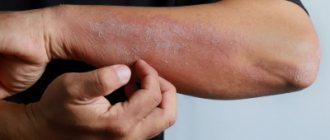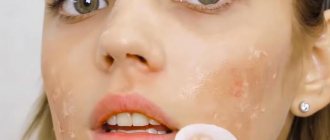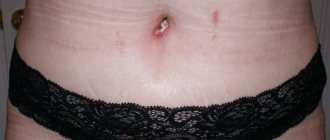Types of subcutaneous acne: how to remove the rash?
You look in the mirror and see a pimple, and the doctor evaluates its size, shape, depth of the process, distribution of the rash, and makes a diagnosis based on these data. There are the following types of subcutaneous acne:
- Furuncle. Acute purulent-necrotic inflammation of the sebaceous gland, hair follicle, and surrounding skin, which is caused by Staphylococcus aureus. Most often they form on the neck, chest, face, and groin area. They look like a nodule or pustule, from which necrotic tissue with bloody pus is released.
- Atheroma is a cyst of the sebaceous gland that occurs due to its blockage. The subcutaneous accumulation of sebum has a dense structure, is visible through the epidermis, and has a white or slightly yellowish tint. Capsule size 5 - 40 mm. When suppurating, it causes pain, swelling, redness, and fever. It is localized in areas of the body where there is hair, most often on the face (near the mouth), head, neck, back, and genital area.
- Papules, pustules. The papule resembles a small raised blister with a diameter of 2-4 mm. This inflammatory nodule has a conical or hemispherical shape. Pustules are papules filled with pus. They can be formed primarily or transformed from papular acne9.
- Nodules, cysts. Localized mainly on the skin of the back and back of the neck. At first the consistency of the nodes is dense, then they gradually become softer. The skin over them becomes bluish-pink, thins, holes form in it, from which pus comes out9.
The method of getting rid of subcutaneous acne depends on its type.
How to treat subcutaneous acne?
Before removing a subcutaneous pimple using a Uno spoon or other instrument, you should think carefully about whether you can do this without aggravating the situation. Inept squeezing out of rashes often leads to the spread of the inflammatory process, skin damage, scar formation, and hyperpigmentation spots. This way you will get rid of acne, but your skin will not become more beautiful, just one aesthetic defect will be replaced by another.
It is important to learn to treat acne as a disease that needs to be treated, and not just get rid of the symptoms.
Clindovit® gel is a medicine for subcutaneous acne. It is a topical antibiotic that can be used to treat mild to moderate acne.6
It is better to learn from a specialist about how to get rid of subcutaneous acne. He will find out what caused the acne, prescribe medications, home care, and may also recommend cosmetic procedures that will help improve the condition of the skin.
An integrated approach to combating subcutaneous rashes is the most correct. But it should be remembered that even those procedures that are intended to treat acne may be contraindicated for acne if we are talking about inflammatory elements (papules, pustules, cysts).
What to do with subcutaneous acne?
Many people are interested in how to quickly get rid of subcutaneous pimple. Unfortunately, there is no recipe that would help remove the inflammatory element in a few hours or overnight. Acne is a chronic, relapsing disease that requires long-term treatment. For example, when using Azelik® gel, it takes approximately 4 weeks to see noticeable results5.
Azelik® is a 15% azelaic acid gel for the treatment of mild to moderate acne, including the presence of papules and pustules. The composition of the Azelik® gel base includes an additional component - the emollient squalane5,7. This ingredient is responsible for softening and moisturizing the skin2. Azelik® has the following properties5:
- helps normalize keratinization processes;
- helps relieve inflammation by reducing the metabolism of neutrophils and reducing their synthesis of free radical forms of oxygen;
- helps reduce the level of free fatty acids on the skin;
- exhibits antimicrobial activity against Propionibacterium acnes and Staphylococcus epidermidis.
Azelik® should be applied twice a day to dry and previously cleansed skin5.
Subcutaneous acne: causes and symptoms
The causes of subcutaneous rashes may be as follows29,50,41:
- Endocrine disorders. The work of the sebaceous glands is influenced by androgens. When testosterone levels rise, they produce more sebum, which can lead to breakouts.
- Heredity. It has been proven that if parents have suffered from acne, there is a high probability that the child will also show symptoms of the disease. In addition, there is genetically determined hyperandrogenism, which causes an increased level of sebum production and affects the processes of keratinization.
- Skin injury. Any mechanical impact on the skin can lead to the formation of rashes. We are talking not only about squeezing out acne, but also about frequent and prolonged rubbing of clothing straps, the habit of resting your chin with your hand, etc.
- Nutritional factors. The role of nutrition in the formation of rashes is still controversial. But there is still an opinion that for acne it is better to exclude milk, fatty meats, desserts, spicy and hot dishes. It is better to stick to a low glycemic index diet.
- Use of cosmetics with comedogenic components. The comedogenicity of individual ingredients in a cosmetic product is highly individual. So, in one person it can provoke acne, but in another it may not cause any negative reaction.
- Taking medications. Glucocorticoids, anabolic steroids, anti-epileptic drugs, even some vitamins can cause rashes.
Another factor influencing the formation of acne is hygiene. By itself, it does not cause acne, but it can help create favorable conditions for bacteria to multiply, increase sebum production, and clog pores. Moreover, this applies to both insufficiently frequent cleansing of the skin and frequent washing.
You need to understand that subcutaneous acne needs treatment. It must be pathogenetic, that is, affecting the links of pathogenesis. Clindovit® gel is active against propionibacteria, which cause acne, and also reduces the level of free fatty acids on the skin surface.6
To effectively combat acne, it is necessary to find out the causes that caused the disease and begin treatment on time.
Causes of formation of papular acne
The problem of papular acne mainly affects young people. In girls, this type of acne is usually more mild.
The changes that appear on the skin during the formation of papular acne are caused by the so-called hormonal storm. At a young age, hormone levels rise rapidly, causing the sebaceous glands to produce more sebum, which does not have time to be removed naturally.
Under physiological conditions, the production of sebum is necessary to create a protective layer on the skin that protects it from external factors. However, its excess, combined with exfoliating epidermis, sweat and dust from the environment, causes clogging of the sebaceous tubules and the appearance of acne, nodules and papules.
Bacteria multiply under the skin, and an inflammatory reaction develops, which is manifested by pain, pinpoint swelling and redness of the facial skin.
Papular acne in adults is caused by excessive stress, inadequate facial care, or problems with hormone (androgen) secretion. The most common problem of adult acne occurs in women, such as during menstruation or pregnancy. Papular changes are accompanied by pimples and acne.
Subcutaneous acne: causes, symptoms, treatment
Unlike ordinary rashes, subcutaneous acne is a problem that is almost impossible to get rid of quickly and easily. They form deep under the dermis, take a long time to mature, are quite painful, attempts to squeeze them out on their own do not bring success, and even if they do, after such manipulations, marks in the form of scars, hyperpigmentation or fistulas remain on the skin for a long time.
Therefore, it is extremely important not to try to remove such an internal pimple on your own and with folk remedies at home, but to promptly seek qualified help. At the Private Practice clinic, treatment is provided by a highly qualified dermatovenerologist, cosmetologist, candidate of medical sciences Valeria Borisovna Yamshchikova. Our doctor has only highly effective and practice-tested treatment methods that successfully solve this problem without consequences or relapses. You can get advice and make an appointment by calling the indicated phone numbers.
Why do subcutaneous acne appear? Common reasons
The occurrence of deep internal formations is almost independent of hygiene. Here the premises are more serious. Traditionally this is:
- endocrine disorders in the patient’s body - during puberty, pregnancy or menopause, taking hormonal contraceptives, dysfunction of the thyroid gland or adrenal glands;
- disruptions in the functioning of the gastrointestinal tract;
- disruption of the sebaceous glands, hyperhidrosis, decreased immunity;
- autoimmune and dermatovenerological diseases;
- unbalanced diet with a bias towards simple carbohydrates, saturated and transgenic fats;
- abuse of deep peels.
In addition, the cause of subcutaneous acne can be demodex (subcutaneous mite). Excluding demodicosis is the first step in the treatment of formations of this kind.
How to recognize a subcutaneous pimple?
At the first stage, the formation is not visually noticeable. There may be slight redness of the epidermis and discomfort when pressing on a certain area. After some time, a compaction can be felt in this place, which gradually increases.
Over time, it becomes noticeable to the eye, and the subcutaneous pimple looks like a bump - a uniform reddish tubercle without a black or white top. Its ripening time may take several weeks. In addition, maturation may stop at one stage or another. In this case, the internal pimple resolves and disappears over time. But don’t think that this is a victory - sooner or later it will appear nearby or in a related area.
Such acne can appear on any part of the body - neck, shoulders, chest, abdomen, buttocks, inner thighs, scalp. Sometimes they can be observed in the armpits and in the face area. Most often, internal acne on the face forms in the chin area: the skin here is the densest, so it is difficult for the formation to “break through” to the outside.
Diagnosis and treatment of acne under the skin in our medical center
Any patient facing the problem described can turn to us for help. To begin with, Dr. Yamshchikova will conduct an examination to identify the causes of subcutaneous acne. This may include the following procedures:
- skin biopsy or tape test to exclude demodicosis;
- blood tests - general, biochemical, hormonal, immunological;
- Ultrasound of internal organs;
- consultations with specialized specialists, for example an endocrinologist.
After the cause of acne under the skin has been determined, the competent doctors of our Private Practice clinic select and prescribe the most effective comprehensive treatment. It includes therapy aimed at improving the functioning of problematic systems and organs to prevent the appearance of new acne, combating existing formations, as well as procedures to restore damaged skin.
Make an appointment at a convenient time and receive qualified medical care!
You can make an appointment with a doctor by calling
+7+7 (495) 980-13-16











